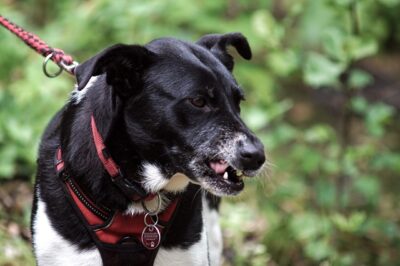The heartbreak of realising your pet has disappeared into thin air is devastating and terrifying. The loss is unimaginable, and the fear of where they are, lost in unfamiliar surroundings, who has them and for what reason, and the dangers of being alone, risk of predators, and general survival is heart rendering.
There are endless websites and Facebook groups where you can upload your pet’s information, and with the right keywords or hashtag (#), someone may search for a similar animal, and your pet’s profile appears in the search engine. Creating your own Facebook page dedicated to your missing pet is important, as bringing public awareness by displaying posters outdoors.
“The UK’s largest lost and found service. And we’re FREE!”
DogLost
- DogLost UK has prominence and primary contacts with various organisations, including the Police, and owners can now upload lost cats & horses too. As a national database, it operates 24/7 and is on Twitter, a main Facebook page, and groups for different counties. People can share your pet’s profile across social media, or old-fashioned posters can be downloaded, printed and displayed in public areas. You’ll find DogLost recommended on websites belonging to authority organisations and featured in articles. The only chargeable feature is the Bark Out Service – a Facebook ad is created, giving more visibility to around 10,000 people on Facebook
“UK’s first uniformed Missing Pet Search Team”
Animal search uk
- Animal Search UK was founded by an ex-Police officer. The database offers the facilities to create a profile for your cat, dog, bird, fish or other little creature. They have a dedicated search team with success, which is chargeable.
All you want is for your beloved pet to be home and safe. So what can we put in place to keep them safe from bad people, living as a stray, being rehomed by a rescue, or losing their life because they cannot survive alone?
How big a problem is dog theft in the UK? “Well, if you listen to the public, it’s huge. But if you look at the actual reports that the Police are gathering, it’s not that big. But the problem we’ve got is it’s not specifically recorded as a crime, dog theft.”
Katy Bourne – Police & Crime commissioner, Sussex
But what steps can you take to prevent your dog from going missing in the first place?
Table of Contents:
- Why a dog might escape a garden
- Stop your dog from escaping a garden
- Find out about dog crime in your area
- 4 Ideas to fight against dog napping from the home and kennels
- Think before you take your dog outdoors
- What not to put on a collar or tag, according to Sussex Police
Why might a dog escape from the garden, and how?

We sometimes face challenges when bringing a new dog into the family because every canine has a different background. Dogs need enrichment to destress and feel confident in their environment. If they are unstimulated in their garden, they may seek interest elsewhere and find ways to escape the garden. If a dog escapes from its safe environment, it then faces dangers – busy roads and vehicles, train tracks, and falling into the wrong hands.
- Breed-specific working dogs have substantial energy to expel and require high-level mental and physical stimulation. An example is the Border Collie. The working dog will need more than a saunter in the back garden. Consider your family life and what you can offer an active dog. For example, agility courses, swimming, and long hiking. You might start by creating an agility course at home, but you need lots of dedicated time to tire a working dog
- Olfactory receptors are not in full use because of the lack of scent in their garden environment. Get planting!
- Plant mint and lemon balm in clumps. Both give energy, and the plants are safe for your canine to sniff and munch on
- Dogs can see yellows and blues, so plant pansies for visual fun
- Lavender and rosemary are perfect calming plants
- Build a sand pit with drainage, and let your pooch dig! Use kid’s play sand only but keep the children away from it because of hygiene, and a dog may not like the intrusion. Oh, please keep it clean, as your canine may use it as a loo
- Any dog needs to be occupied mentally. If the garden lacks facilities, it may escape and seek enjoyment elsewhere. For example, a dog may follow its regular walking route to its favourite place that provides scent, places to roll about in, fresh air, and sound
- Puppies are like children, oblivious to danger and can squeeze through the tiniest gap. It is essential to secure your garden
- Abused overseas dogs – rescue dogs from countries like Romania may be terrified of men because of the brutal treatment of the dog catcher and torture in public kill shelters. Equally, following its journey on the Happy Bus, in a dog-friendly shelter, veterinary checks, 2 to 3 days travelling in confinement to Europe, and being kennelled in another shelter, then rehomed into a home environment they have never experienced before can be too much. Trauma, changes in its life, and living in a home with unknown sounds and smells can be terrifying, and the need to escape is heightened dramatically. Trigger stacking is a factor when fear builds up over time. Read about Chief.
- Pets can be targeted in a domestic abuse environment if the pet belongs to the victim. Domestic abuse worsens, and when it becomes violent for you, it may become violent for your dog. So your dog may seek a way to escape the abuse. Some charities can place a pet in a temporary foster care system, removing them from a domestic abuse environment. Written with authority
- When a young dog reaches around six months old, he may feel the urge to find a female to fulfil his sexual urges. Speak to your vet, but neutering and spaying are normally around four months old
- Young dogs especially can get bored in the home and the garden if mental, olfactory and physical needs are not met and may decide to find avenues to meet their own needs
How to stop a dog from escaping a garden
Rescues tell us to secure a garden with a 6-foot fence, but large dogs can still scale a high fence, and small dogs may dig their way out. It depends on a dog’s personality and background too. What can we do to add other preventative measures?
- A 45-degree inward-angled fence topper (designed to catproof a garden) is ideal for stopping dogs’ scale high fencing. DIY kits can be purchased from Felisafe and improvised to suit dogs or fit your own with purchased materials. Watch the Video: Cat proofing a massive back yard – under $300/£245
- Ensure bins, tables, chairs, log sheds, outdoor dog houses, or any large structures that can be used as a climbing frame to jump across a fence or gate or moved
- Some dogs enjoy digging, and a small dog may opt to do this. To prevent digging around the fence perimeter, use chicken wire. Dig about 12″ deep and 6″ to 12″ wide into the earth and lay the wire. Cover with soil and another option is laying heavy rocks or broken slab pieces on top to create weight. Nail a section of the chicken wire securely to the base of the fence or wall. If you are worried about unsightly rocks or broken slab pieces, sprinkle alyssum seeds over the soil; the low-spreading plant quickly grows and looks pretty. Tip: Make a sandbox for a dog who loves digging
- Plant rose bushes and prickly hedging along the fence base, like Pyracantha. These bushes also protect wild garden birds.
- Look out for gaps in the fence and wind damage and repair
- Invest in an armoured high security container padlock or an alarm padlock to prevent intruders or visitors from leaving the gate open. Watch the video: Home safety tips from an ex-burglar
How to find out about dog crime in your area or nationally

Police forces are becoming more aware of dog theft, and several forces liaise with DogLost, a FREE 24/7 national database. Sussex police began Operation Collar to prevent dog theft which has escalated since the 2020 lockdown, and the demand for puppies and dogs increased.
The following statistics are based on the Sussex area during 2020 and the disappearance of 31 dogs that year:
| Volume | Outcome for the dog |
|---|---|
| 12 | Ownership dispute **in a new relationship, ensure documents are drawn up about the ownership of a pet should there be a relationship separation or divorce |
| 6 | Taken by a third party unknown to the owner |
| 6 | Lost and not stolen |
| 3 | Owners stopped contacting the Police so the outcome is unknown **possibly excluded from the 31 cases |
| 7 | The dog was found nearby or reunited via a vet |
- Dog Watch is a FREE scheme set up by Essex Police. It is for dog owners, vets, rescues, groomers and pet services. The member receives weekly updates about dog-related crimes, helping to bring awareness about keeping your dog safe at home, in the garden or on a walk. Search on Google for your local county.
- Other schemes:
- Rural & Wildlife Crime
- Horse Crime. For example, West Yorkshire Police have Horse Watch Scheme
- Dog Watch asks you to report anything suspicious.
- Are you being watched?
- Do you feel uncomfortable about someone?
- Is someone distracting you from your dog? An incident occurred when a man wearing a hi-vis vacated his car and asked the owner about the dog’s breed. This was reported, but no further action was taken.
- Sign up with Dog Lost and receive your area’s missing and found dog alerts. You can help share a dog’s profile on social media but ask yourself if a breed pattern exists in a particular area.
- If your dog has been stolen, call 101 and get a Crime Reference Number
- Join Facebook groups and help make dogs ‘Too hot to handle’ by sharing posts of the lost and stolen, and displaying posters locally.
- Go to YouTube and search for videos on Dog Theft because you can learn more about safety
The following videos cover dog crime and interviews with criminals:
- The gangs that steal your puppies – Crimewave **features dogs already stolen
- Dog thefts in the UK – BBC Daily News
Dog Watch urges you to walk your dog on-lead and know that dog napping happens day or night.
4 ideas to fight against dognapping from the home or kennels

A dog theft criminal was asked how steal a dog or puppy from a property – “A lot of the time, that’s what we do (steal from properties). We can scope the place out that’s got a dog that we know has got litters … we won’t the puppies, mainly … alot os the time they (public) don’t want a full-grown dog.”
Dog thief criminal interviewed on crimewave
Dog theft from within the home has increased, especially if puppies are for sale, a dog is not spayed or neutered, or breed-specific if popular, and a profit can be made. According to DogLost and Countryside Alliance, 50% of stolen dogs are working dogs from rural areas. These breeds can sell for around £5000.
Admittedly, criminals are becoming more confident and aware of our preventative measures against our dogs being stolen from our homes, gardens or kennels. For example, when Missy and Biscuit were stolen from their kennel on 5th March 2021, thieves accessed the property (Tinkers Lane, Brewood, Stafford, ST19) over fencing, hedges and two gates. Outdoor CCTV was unplugged.
Watch more about Missy & Biscuit (start the video at 14 mins). What can we do to hopefully increase our dogs safety?
- Invest in an alarmed padlock with a built-in sensor that activates an alarm if tampered with for the back gate or kennel. The alarm will react from vibration or when tampered with. The range of the siren is between 110dBs to 120dBS which equals a power saw and thunderclap.
- Add multiple locks to deter access to the kennel. Make entry as difficult as possible
- Install CCTV – Ring sells remote access outdoor security cameras with motion sensor security lights and siren. Compatible with Alexa and Smart devices for remote access. However, ensure criminals cannot unplug or cut the wires of your CCTV cameras. Ensure this covers the kennel too
- Fit locks to the top and bottom of gates. Sussex police advise shoot bolts and padlocks
- Can thieves cut through wire fencing or remove old kennel panels?
- Countryside Alliance suggest building the kennel as close as possible to your home
- If using an indoor camera, add extra deterrents:
- Door handle alarms that sound with movement. On average, the siren is 120dBs
- Ring has window alarm sensors, but you need a Ring Alarm Base Station. Alternatively, low-priced window alarms; ensure the red warning sticker is UV protected. Normally, the cheaper options are battery operated
- Display signage deterrents are worth buying: warning stickers, CCTV or door alarm signage, or mobile monitored home security stickers to exterior windows.
- Keep a check on gates, fencing and walls for white chalk markings. Thieves mark the property – they know you have a dog and want it. They will come in daylight and break into your home. Watch the Video: Dog theft in progress
- Sussex Police recommend investing in driveway alarms and extra CCTV as a deterrent
Read more about Lassie stolen from her garden.
Think before you leave your dog alone outdoors

Answered in relation to a Labrador appearing in the woods alone – “Yeah, where is the owner? You’ve got to keep your eyes on your dog at all times. Don’t just let your dog run ahead of you and run around the corner before you because what happens is we might be waiting.”
dog thief criminal interviewed on Crimewave
As career criminals say, stealing dogs is a lucrative business, and the risk of arrest and imprisonment is minimal. Combined with the demands from the public for breeds and alarmingly, buyers are not asking questions, the business will continue. Puppies at home are the target for profiteering, and working dogs fetch thousands of pounds. These dogs can be used as breeding machines, having several litters annually. Young dogs, particularly older ones, may be stolen for dog baiting and certain breeds for dog fighting. Of course, some lost dogs never become stolen, but we must take preventative measures. Before you let your dog out of your sight, remind yourself it can happen to you.
Our dog relies on us, so how can we protect them?
- Invest in leads, harness and collar with stainless steel wire inside and the addition of combination locks. Ted was stolen when his owner was attacked in a woodland park
- Keep your dog in sight and on a lead. Maple was stolen and thrown into a car. Maple was reunited in April 2023 – read how she was found a year after being stolen
- Be careful of people you don’t know stop asking about your dog Blue, an elderly Sprocker, was stolen when a man with a dog chatted to the owner and has been regarded as distraction theft
- Never tie your dog up outside a shop. In seconds, a thief can unclip a standard lead from the collar.
- Walk your dogs with others. There is safety in numbers
- Walk in busy, well-lit areas, and if taking your dog out at night, walk with someone. Eco was stolen when on a 2 am off-lead walk. The owner heard tongue clucking, and Eco disappeared
- Change your walking route and times
- Dog thieves admit to targeting parks. It’s probably because dogs are walked off-lead and can quite easily be hidden from view of the owner with trees and hedges nearby
- Carry a personal alarm or purchase a dog lead with an attack alarm to alert people nearby you need help. Make sure the alarm sounds for at least 30 to 60 minutes. This pack of 3 alarms can be heard up to 750 feet away with its 150dBs siren
- If your loved one has Alzheimer’s or Dementia and walking their dog, anyone can persuade that person to hand over their dog. This happened to 14-year-old Skye. Thankfully, social media publicity making her ‘Too hot to handle’, Skye was reunited with her family after a week
- Elderly dogs are less likely to survive out there alone. Keep your senior dog on a lead. Scuttle was being walked in woodland and went missing in January. His body was discovered in March. Your canine may have doggy dementia so keep your dog on a lead
- Invest in a GPS device that attaches to a collar. Tractive is popular: Tractive GPS Dog Tracker with live location and unlimited range.
- Do not put your dog’s name on the ID tag or collar. This stops anyone from calling your dog to them. Add your surname instead
- Be vigilant around you. Find out if the Police have Dog Watch in your area
- Never leave your dog alone in a vehicle. Heatstroke is one reason. The other is a smash-and-grab. Bjorn was in a van, the window was smashed, and Bjorn was stolen. At the time, the vehicle was parked in Bluewater’s busy car park outside John Lewis. Bjorn is a male Bolognese breed and was sold for profit, but because he was made ‘Too hot to handle’ with his own Facebook page, the new owners recognised him as a stolen dog, and he was reunited. Other dogs have not been so lucky.
Related articles:
- Category: Lost, Found and Recovery of Pets
- Dog Lost UK – 90,000 dogs reunited – why and how it began
- Muddy Paws Crime – Stop illegal breeding and trafficking between the UK and Ireland
- Security measures for your dog – the new anti-theft walking gear for the pooch
- 10 Tips to stop your dog being used as bait in dog fighting rings
- Trigger stacking – fear builds up until one innocent occurrence tips a dog over the edge
The pros and cons of pet ID
Microchip – A responsible dog owner microchips their pet. The chip must be implanted by a Government approved reputable organisation such as a vet or rescue centre. Even if the implanter has completed a form with details, as the owner, you need to contact the microchip database to register the chip, and give them your contact details to link both – this is the only way to be reunited with a lost pet. Always keep any microchip documentation safe. Nowadays, databases charge around £20 to update contact details, or to activate the lost pet service. However, you can update and activate a lost pet service for FREE with Pet Database. It’s also easy to transfer from your old chip company to Pet Database, and it doesn’t matter if your pet is lost or at home. My pet is missing, and I transferred Sam’s details easily.
The microchip and the thief – a dog’s value in Europe is about £300, but in the UK, the value can reach thousands. Dogs stolen in Europe have the chip removed in the UK by criminals and a new chip inserted. I suspect the microchip is unregistered. They are advertised online and sold as British dogs to an unsuspecting new owner. The same can happen to a stolen UK dog – the microchip is removed and sold to another person.
Collar details – Microchipping a pet is a good idea, and adding a mobile or landline number onto the collar is a quicker way for the finder to contact an owner. Etsy has a wide range of stores offering to engrave or stitch a pet’s name onto a collar. Sussex Police suggest adding a surname instead of a dog’s name because a potential thief cannot call the dog.
As experienced, when someone sees a dog alone and walking their dog, they don’t always approach the found dog. However, they may direct the owner to where the dog is.
The collar and the thief – thieves breed dogs several times a year so add neutered or spayed to the collar.
ID tag – legally, your dog must wear an identity in public places. Include your contact details, your surname, and whether neutered or spayed. I recommend attaching an additional tag with medical information too. If your pet is handed to a vet, at least they will know of any health issues.
The ID tag and the thief – with neutered or spayed on the tag, it may put the thief off if plans are for breeding, but if for reselling, it won’t matter.
Key takeaways
- Add your surname to your dog’s collar instead of its name
- Include neutered or spayed on to your dog’s collar
- Transfer the microchip to Pet Database. Update contact details and activate the lost pet service for free
- Secure your garden with angle-fenced toppers and underground wire
- Never leave your dog outside a store
- Create an enrichment in the garden to prevent a dog from wandering
- Secure the garden and kennels with high-quality padlocks
Poppys Pets is a participant in Awin and Amazon Associate affiliate programs which compensates me for referring traffic. It is of no extra cost to you and if thinking of buying a product, please consider using my link. It\'ll earn Poppy\'s Pets a few pennies to continue to this website. Only a selection of articles and videos on this website and YouTube channel contains affiliate links. Further information: Disclaimer and Privacy Policy
Poppy’s Pets has a column in the Withernsea District & Community News, including a section for missing pets


